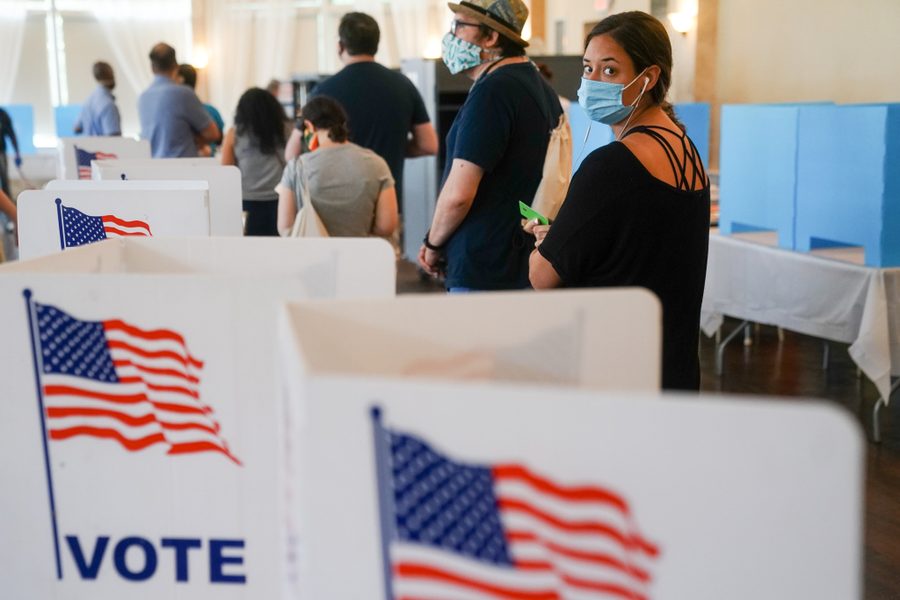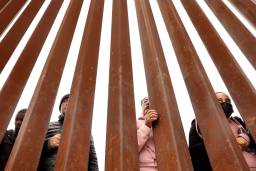DHS Is Using Immigration Crackdown to Suppress the Latino Vote, Critics Say
From expediting deportations to placing “wanted” billboard ads across Pennsylvania, rights advocates warn DHS is intimidating voters.
Maurizio Guerrero

In the lead up to Election Day, the Department of Homeland Security (DHS) is trumpeting its raids of undocumented immigrants, expediting deportations, and putting up “wanted” billboard ads of “criminal aliens” across Pennsylvania. Rights advocates say these tactics appear aimed at boosting President Donald Trump’s reelection chances by intimidating immigrants, Latinos and other Black and Brown voters, who are more likely to favor Democratic candidates.
“We are walking a fine line,” says Philip Wolgin, managing director of immigration policy at the Center for American Progress, a think tank that is influential with the leadership of the Democratic Party. “We want to make sure that people are aware of what’s going on and how to be prepared, particularly local officials who have the onus of protecting elections, while also not causing fear in immigrant communities and ending up doing the type of voter suppression that we think the DHS and the government are trying to do right now.”
As voter participation sets record numbers, DHS may be seeking to dampen this enthusiasm, critics say. On October 21, the Immigration and Customs Enforcement agency (ICE) — a DHS agency in charge of combating “unauthorized” immigration—announced the implementation of its expedited removal policy, whereby it can arrest individuals anywhere in the country and deport them in a matter of days without a court hearing if individuals cannot prove, to the satisfaction of the officials, that they have resided in the United States for at least two years. The timing of the announcement of this policy, suggests Wolgin, could dampen voter participation.
“Most U.S. citizens probably do not carry on them documents that show that they’ve been in the country for two years. I personally do not carry my passport with me at all times,” says Wolgin. “So, there’s a real concern that, given the long history of racial profiling and using immigration to go after Black and Brown people, we could end up with ICE detaining some folks based on this provision. That’s not out of the realm of possibility.”
False rumors have amplified this possibility. According to an October report by the Brennan Center for Justice — a nonpartisan law and policy institute at the New York University School of Law — groups that are intentionally trying to suppress the vote among people of color have spread the falsehood that ICE agents will surely patrol the vicinity of polling places. “Some of these rumors appear to have come from groups that are intentionally trying to suppress the vote among Latinos and other people of color,” states the report. “These rumors create real fear in communities ICE has targeted with increasingly aggressive tactics.”
On top of expedited removals, DHS appears to be publicly championing its crackdown on immigrants. Earlier in October, the Acting DHS secretary, Chad Wolf, touted in two press releases the arrests of almost 300 immigrants after week-long operations in six cities and the whole state of California. The operations, however, did not mark a shift in course but were consistent with the Trump administration’s high arrest rates.
Rights advocates say the timing of these public statements about DHS arrests is no coincidence. “The DHS is doing everything it can to promote these political stunts two weeks before the presidential election,” says Salvador Sarmiento, national campaign director at the National Day Laborer Organizing Network (NDLON), a grassroots organization that promotes immigrant workers’ rights. Sarmiento adds that the Trump administration’s objective is to instill fear in immigrants and people of color, who out of caution may be discouraged from interacting with any kind of officials, including at the polling stations.
NDLON has denounced a prominent DHS initiative to criminalize undocumented immigrants. In early October, ICE started putting up in Pennsylvania six billboards with “wanted” ads showing the pictures of “criminal aliens” — all of them people of color. ICE claims the individuals pose a “safety threat,” even though five of them have not been convicted. According to a memo by the Center for American Progress, the “wanted” ads represent a new gambit. “Such race-baiting may especially lead to escalated risks for Black and Brown citizens seeking to cast their vote, which in turn could have a chilling effect on their ability to participate fully in the election,” states the document.
New tactics are paired with the old myth that undocumented immigrants do vote and sway elections. With no proof whatsoever, Trump himself repeated as recently as 2018 that millions of undocumented immigrants voted in California in the 2016 election. He set up an investigative commission led by Vice President Mike Pence and then-Kansas Secretary of State Kris Kobach, which failed to find any evidence of voter fraud.
Despite the commission’s failure, ICE did manage to announce in August 2018 charges against 19 foreign individuals for voting illegally in North Carolina in 2016, although in similar cases elsewhere people were just confused about their eligibility to vote. Those votes were negligible considered the 4.8 millions votes cast in 2016 in North Carolina. These stunts could contribute to mobilizations across battleground states for the “Army for Trump’s election security,” which was convened by Donald Trump Jr. and aims to establish a 50,000-strong army of “observers.”
Climate of intimidation
There is already reason to be concerned that this climate is encouraging vigilante intimidation of voters. As of October 23, there have been at least four documented instances of voter intimidation during the early voting processes. In September, a group of Trump supporters waving campaign flags in Fairfax, Virginia, stood in the way of voters attempting to reach the polling station. In Florida, a police officer in uniform was photographed outside a voting site wearing a pro-Trump mask and a holstered firearm. In Philadelphia, the Trump campaign videotaped citizens depositing their mail-in-ballots, which local authorities considered improper conduct. And in St. Petersburg, Florida, two armed security guards at a polling station prompted officials to station deputies at five voting sites.
There have been initiatives to prevent further voter intimidation. In Minnesota, the Council on American-Islamic Relations sued the private security company Atlas Aegis for recruiting ex-U.S. military special operations soldiers to deploy to polling places, calling it a breach of the Voting Rights Act of 1965. In Michigan, the Secretary of State ordered a ban on the open carrying of firearms within 100 feet of polling places.
In this atmosphere, rights advocates worry that the U.S. Customs and Border Protection Agency (CBP) — part of the DHS — could deploy its paramilitary unit Bortac (Border Patrol Tactical Unit) as it did in July during the protests against police brutality in Portland, Oregon, where the the force kidnapped protesters and threw them into unmarked vans. In the midterm elections of 2018, CBP planned to conduct a “crowd control exercise” near at least one polling location. Those plans were scrapped after an uproar.
“Our big fear is that we see a reprise of Portland, with ICE and CBP being used to intimidate voters on election day or around election day, whether by sending agents directly into the polls as members of the government have said or just by deploying them around cities,” says Wolgin.
Although polling station disruptions could happen on November 3, they should not be overstated, says Sean Morales-Doyle, deputy director of voting rights and elections at the Brennan Center for Justice. Deploying armed forces in polling sites is illegal. Amplifying this possibility could in itself dissuade people from voting. At the same time, acknowledging that voter intimidation attempts are real allows local officials and activists to strategize on how to offset them.
“I do have some concerns that one of these incidents would get out of hand. Similarly, I worry that the police may be too quick to engage, or that some jurisdictions would be too quick to call law enforcement sort of preemptively because of these fears,” says Morales-Doyle. “I worry that people are going to respond in these moments of heightened tension by escalating rather than by de-escalating.”
This election will be less protected against voter intimidation than the previous one. During the 1981 New Jersey’s gubernatorial race, aggressive intimidation tactics by off-duty law enforcement agents were so blatant that a decree adopted a year later sharply limited the Republican National Committee’s poll monitoring activities. That decree expired in 2017.
“This would be the first presidential election where there has not been a federal judicial consent decree in place that prevents the Republican Party from engaging in certain types of ballot security operations and polling intimidation efforts,” warns Morales-Doyle. With fewer legal protections, several initiatives are planning to ward off any endeavors to tamper with the voting process.
The Voter Protection Program, for example, was formed by litigators with state and federal government experience in both Republican and Democratic administrations, as well as national experts on voting rights and election protection, and communications professionals. It also includes a bipartisan board of former governors, attorneys general, and local, state and federal law enforcement leaders.
Advocates, meanwhile, say the voters targeted by the intimidation tactics have a vital role to play in this election — and their participation is sorely needed. “Immigrants across the country have demonstrated the greatest examples of courage that we can be inspired by when they show up to work in the middle of the pandemic or when they walk thousands of miles to give their children a better life,” says Sarmiento. “We are all called today to show that same courage.”
As a 501©3 nonprofit publication, In These Times does not oppose or endorse candidates for political office.
Maurizio Guerrero is a journalist based in New York City. He covers migration, social justice movements and Latin America.








